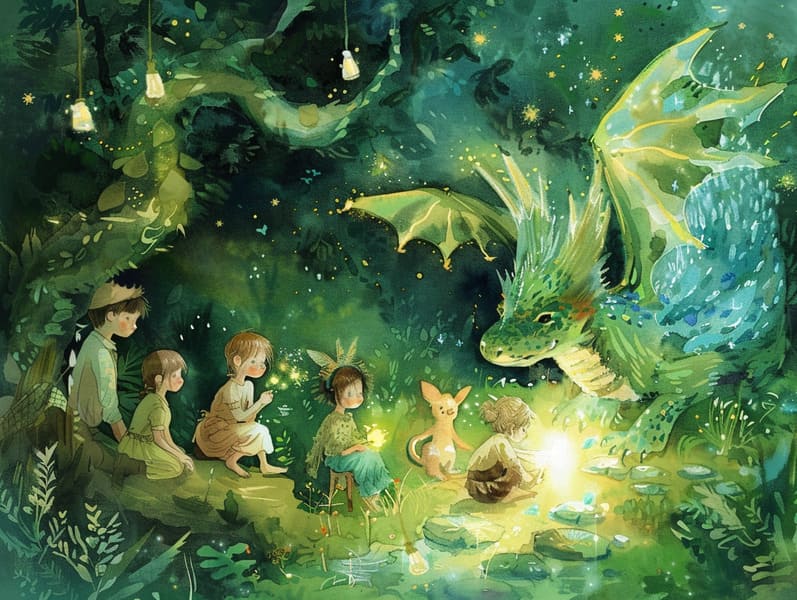
Historical fairy tales have ancient roots. These narratives have been recounted from one generation to the next well before they were ever published. They arose from a variety of societies, including Western traditions. They were initially narrated among adults, often carrying themes and messages reflective of the societal norms and beliefs of the time.
Jacob and Wilhelm Grimm, Jacob and Wilhelm Grimm, were among the first to compile and publish many of these beloved narratives. Their published works, "Grimm's Story Collection," included classics like "Cinder Maid," "Hansel and Gretel," and "Little Snow White," which have since become hallmarks in the world of famous fairy tales. Similarly, the Danish author's fantastical narratives, such as "The Story of the Little Mermaid," and "The Duckling that Could," have enchanted hearts worldwide, securing their place in the pantheon of timeless fairy tales.
Even though they are old, traditional fairy tales remain as relevant as ever, especially as bedtime stories for kids. These charming stories are now available in numerous formats, including beautifully illustrated books, enchanting animations, and digital fairy tales.
Their lasting presence can be ascribed to several fascinating points:
Valuable Lessons: Classic fairy tales often teach important moral lessons. Fairy tales like "The Story of the Boy Who Cried Wolf" teach the benefit of being truthful, while "The Tale of the Tortoise and the Hare" emphasize the benefits of steadfastness and humility. These tales offer young readers clear distinctions between correct and incorrect, guiding their moral compass in a tender yet significant way.
Empathy and Awareness: Traditional fairy tales frequently depict individuals facing struggles and tests, urging young readers to sympathize with their struggles and champion their triumphs. For instance, "The Story of Beauty and the Beast" emphasizes the importance of appreciating inner worth to appreciate the true character of a soul, cultivating insight and appreciation.
Cultural Comprehension: Many timeless fairy tales are rich in the cultural contexts from which they bloomed. Exploring these tales can provide intriguing perspectives into different traditions, nurturing a sense of global appreciation and understanding.
Creativity and Imagination: The magical elements in classic fairy tales—magical kingdoms—awaken children’s creative dreams. These stories take readers to mythical realms, motivating fantasy-filled thoughts check it out and a sense of enchantment that remains a lifetime.
Classic fairy tales are not only fantastical but also teaching. They serve as entrancing tools in strengthening various mind and heart abilities in little ones. When old fairy tales are spoken out loud, they foster verbal skills by bringing new terms and detailed sentence structures. This practice also fosters hearing perception and concentration, as little ones concentrate deeply, ready to see what happens next.
Furthermore, talking about the themes and characters of old fairy tales can sharpen problem-solving abilities and problem-solving abilities. Kids are guided to detect patterns, expect results, and comprehend cause and effect. These talks also contribute to young ones convey their thoughts and feelings, promoting their emotional intelligence.
In today’s high-tech era, the presence of internet fairy tales has made these stories more acquirable than ever. Internet resources and programs make available wide arrays of popular fairy tales that can be read or listened to anytime, anywhere. Fairy tales read aloud are particularly sought after, offering an enjoyable way for children to take part in these bewitching tales. Audiobooks and narrated videos take characters and settings to life, often paired with charming musical scores and harmonies that amplify the storytelling experience.
The timeless charm of old fairy tales lies in their ability to change to today's world while staying true to their basic principles. Contemporary reimaginings of these stories often include more multicultural characters and modern settings, making them accessible to today’s audience. However, the central morals of gallantry, empathy, and even-handedness remain unchanged, continuing to touch young listeners of all ages.
Classic fairy tales also offer a sense of familiarity and closeness. They impart a methodical narrative with a distinct beginning, middle, and end, often ending with the solving of conflicts and the triumph of virtue over corruption. This assuredness can be solacing for children, showcasing a sense of reliability in an constantly changing world.
Classic fairy tales continue to fascinate and instruct new generations, maintaining their attraction and significance in modern society. As bedtime stories for kids, they furnish a perfect blend of enchantment and education, boosting moral values, empathy, and creativity. The existence of digital fairy tales and the popularity of fairy tales told out loud validate that these classic tales remain acquirable to new generations.
By sustaining and passing on these stories, we continue to exalt the rich tapestry of folklore and cultural heritage. Whether you are seeing a vibrantly illustrated book, perusing a virtual collection, or listening via an read-aloud story, the loveliness of Grimm's fairy tales is always within reach. These stories convey of the endless essence of tales and its ability to tie us across time and space.
Even if you are seeing a artistically illustrated book, exploring a cyber library, or hearing an audio story, the splendor of Grimm's fairy tales is always within reach.
These narratives demonstrate of the lasting nature of tales and its ability to unify us across epochs and places, casting a charm that charms and informs alike.